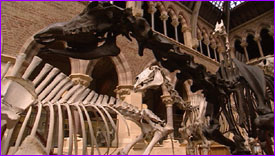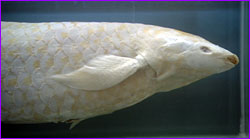 |
 |
|
|  Some
tetrapods
Some
tetrapods
|
Diva of the Devonian
Part 2 | Back to Part 1
From fish to four legs
NOVA: What exactly is a tetrapod?
Clack: A tetrapod is an animal with four legs—you, me—or an animal whose
ancestors had four legs. So I can talk about a frog, which jumps; a bird, which
flies; a snake, which wriggles; a whale, which swims. They've all either got
four legs now, or they had four legs earlier in their evolution. The word is an
inclusive word to denote all those animals, and the fact that they are
ultimately related to each other. They all go back to a common ancestor—in
fact, the very kind of animal we're talking about here.
NOVA: And why is it important to study the first tetrapods?
Clack: Well, the origin of animals with legs marks one of the biggest
transitions in evolution. The transition from water to land, from breathing
primarily in the water to breathing primarily air, that transition allowed land
animals like dogs and cats and dinosaurs and ourselves to evolve. If these
early animals hadn't made the transition, we wouldn't be here today. It's
important to understand how and when, and possibly where, that transition took
place.

 Our closest living relatives among the fishes: the
coelacanth (top) and the lungfish.
Our closest living relatives among the fishes: the
coelacanth (top) and the lungfish.
|
|
NOVA: What do we know about what this transition was like?
Clack: The transition from water to land, from creatures with fins swimming in
the water to creatures with legs, with fingers and toes, we think took place
perhaps around 370 million years ago. That's the first evidence we have of it.
Now, at this time there were plants on the land—quite complex plants. There
were creatures like centipedes and millipedes, old ancestors of those. There
were all sorts of other "creepy-crawlies," if you like. But there were no
creatures with bones.
What we think happened is that during that period, there was a group of fish
that had fins, that had a particular pattern of bones in their makeup. For
example, we have a single bone in our arm that joins to the shoulder girdle.
That's quite characteristic of tetrapods, but also of the tetrapods' closest
relatives. These are called lobe-finned fishes. There were lots of them around
during this period of the Devonian. We have a few others today, like the
coelacanth and the lungfishes. They are our closest relatives among the fishes.
But in that period, they were a whole lot more diverse than they are
now.
Some of them seem to have become waterside creatures feeding in shallows,
finding their way through dense vegetation, pushing the vegetation aside, and
hiding among weeds in swamps. So we're dealing with shallow-water forms that
were ambush predators.
NOVA: And some of these evolved to walk on land?
Clack: Eventually, yes. First, you began in this period to get plants invading
the water margins, forming dense swamps and forests around the water's edge.
And some of the fishes living in the shallows would have found it advantageous
perhaps to lose the fin webbing from their fingers and develop separate digits.
Fish have bony supports for the fin web. If you lose those and make the digits
separate, then you can begin to grasp things and push aside the vegetation. You
can also grasp the vegetation to hold your position in the water. There are
quite a lot of modern fish that do this. You find that they're lurking
predators; they will sit motionless and then suddenly pounce. Many of these
early vertebrates, the fishes and the early tetrapods, have got big deep tails
to give them thrust through the water.
|  Gape-mouthed, many-toothed, and eight-fingered: Acanthostega as it may
have looked back in the Devonian.
Gape-mouthed, many-toothed, and eight-fingered: Acanthostega as it may
have looked back in the Devonian.
|
What we think happened is that these creatures, which were developing this mode
of life in the shallows, developed legs with digits before they ever started
really to walk on the land at all. So they would have got their legs first,
then gradually perhaps moved into shallower and shallower water—more and
more vegetation and less and less water—and eventually emerged onto the
land. But it took a very long time.
NOVA: Is this new? Did we used to have a different idea about this
transition?
Clack: The story that you'll find in many of the old textbooks, and the
pictures that you'll see in children's books and museum galleries, is a picture
of a fish, usually it's a fish called Eusthenopteron, which is stranded
in a drying pool trying with its fins to support itself out of water. It looks
really odd if you look at it objectively, because this fish looks like a pike;
it literally looks like a fish out of water. The old idea was that the fish
came onshore first and then developed the legs. What we now think is that the
tetrapods developed the fingers first and then left the water.
NOVA: Why did we used to think that?
Clack: Because there was very little evidence one way or the other. Among the
first people to think about it was [vertebrate paleontologist] Al Romer in the
States. He and his colleagues worked on what little evidence that there was.
The fish, Eusthenopteron, was one of the best-known of the Devonian
fishes. It has this lobed fin with the structure that some people thought would
have given it an advantage in crawling over drying land to get to another pool.
I don't really think that's plausible, partly because there's no evidence that
they lived in this really arid climate that the model supposed.
Continue: Enter Acanthostega
Photo credits
A Brief History of Life |
Diva of the Devonian
Confessions of a Preparator |
Evolution in Action
Resources |
Transcript |
Teacher's Guide |
Site Map |
The Missing Link Home
Search |
Site Map |
Previously Featured |
Schedule |
Feedback |
Teachers |
Shop
Join Us/E-Mail |
About NOVA |
Editor's Picks |
Watch NOVAs Online |
To Print
PBS Online |
NOVA Online |
WGBH
© | Updated February 2002
|
|
|
|